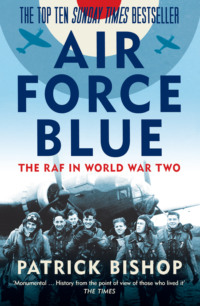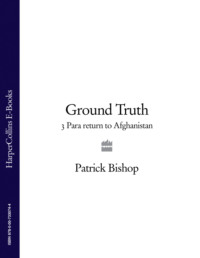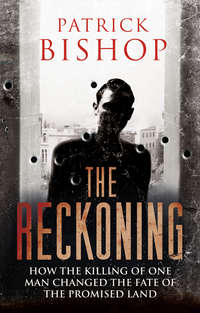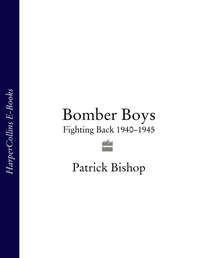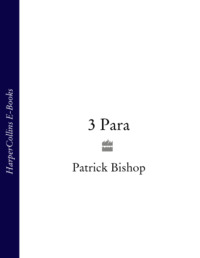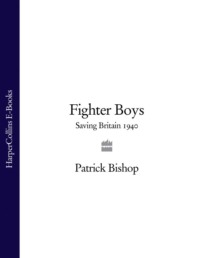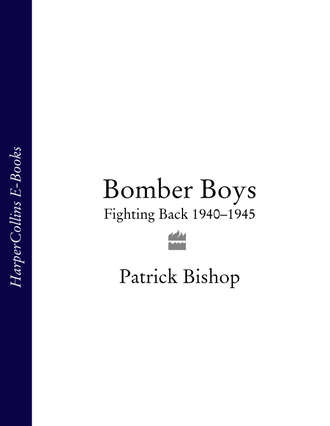
Bomber Boys: Fighting Back 1940–1945
Len Sumpter, a Corby steelworker and former Grenadier who had been recalled to the colours at the start of the war, was training recruits at the Guards Caterham depot when it was hit by German bombs. ‘We took a real hammering,’ he said. ‘A lot of people were killed there.’ When advertisements appeared calling for volunteers for aircrew he applied, impelled by the thought of ‘a little bit of excitement’ and ‘a bit of personal anger’.20
Britain’s vulnerability was brought home to Ken Newman when in August 1940, a month after his eighteenth birthday, he watched Croydon airport being attacked by waves of Stuka dive-bombers. When the Blitz began he made his way each day from his home in Norbury to the City where he worked in the accounts department of a mortgage company. One Sunday night in October, the sirens sounded and he hurried his parents to their air-raid shelter. He was ‘just closing the door when I heard bombs screaming down towards us. There was no mistaking they were about to hit us or fall very close indeed and I must admit that I was very frightened and thought our end had come. Crump went the first bomb, quite near … accompanied by the sound of splintering wood, smashing glass and falling masonry …’ So it went on. When quietness returned he opened the shelter door. The air was swirling with brick dust and the house was gone. There was ‘no sleep for us at all that night. My mother was weeping in a corner of the shelter, partly over the loss of her much-loved home and also in relief that we had survived.’ Later, when asked for his reasons for wanting to join the RAF he told the chairman of the selection board that he was ‘keen to become a bomber pilot in order to have my revenge’.21
Those who had already joined up were glad they had done so when they heard the news from home. Doug Mourton, a wallpaper salesman before the war, was undergoing his RAF training at Abingdon when on 17 September his mother wrote to him from south London. ‘Things are very uncomfortable here at present but we are getting used to it … they don’t give us five minutes’ peace. [Aunt] Beat’s house was bombed and they have come to live with us. There [are] fourteen of us living in the cellar …’ 22
The recruits went off to war in a spirit of optimism. Joining up dispelled the feeling of impotence that aerial bombardment generated and the air force provided the most immediate means of hitting back. There were some restless spirits who welcomed the excitement and openings that war has always offered.
When the storm finally broke Leonard Cheshire was leading what would seem to many an enviable existence, studying law, none too diligently, at Oxford. He was easily bored and game for challenges, which had led him to join the University Air Squadron. His log book recording his flights paused at the end of August 1939. Under the heading WAR he wrote: ‘a heaven-sent release … a magic carpet on which to soar above the commonplace round of everyday life.’23
By the end of 1940 every Briton was faced with an unavoidable truth. There could be no accommodation with the Nazis. If Britain was to remain Britain it would have to fight and after the fall of France the RAF was the only force in the world that was directly attacking the Germans on their own ground.
Thousands of miles away, across oceans and hemispheres, this conviction was felt almost as deeply as it was at home. Imperial attitudes and arrangements were changing. Colonies had become Dominions and were taking their first steps to independence. Yet the cultural and emotional fabric of the empire was still densely woven and strong. At the start of the war, the official instinct of Canada, South Africa, Australia, New Zealand and Rhodesia was to rally to Britain, even though their interests were, for the time being at least, unthreatened by Hitler’s foreseeable ambitions. They immediately offered their young men to bolster the ranks of the RAF.
Altogether 130,000 men from the Dominions served as airmen in the RAF, almost 40 per cent. One in four of the Bomber Command aircrews was from overseas and 15,661 lost their lives. Of those, 9,887 were from Canada. Canada’s cultural ties with Britain were less established than those of other Dominions. Volunteers tended to think of themselves as answering a call to fight for their own country, rather than going to the aid of a faraway mother nation. Ralph Wood came out of church in Woodstock, New Brunswick, on the morning of Sunday 11 September to find newsboys hawking special editions of the local newspaper, the Telegraph-Journal, announcing that Canada was at war with Germany. As he walked back to the home of the parents of his girlfriend Phyllis he confronted the choices before him.
I knew I had fear of being labelled [a] coward or yellow if I didn’t volunteer my services to my country. I knew also that I had fear of losing my life if I did volunteer. There was no contest. All that remained was to choose the service I would join. The Navy? No way! I’d probably be seasick before we left the harbour, let alone battling those thirty-foot waves at sea … The Army? Well according to stories of World War I, which was the only reference we had to go by, this meant mud, trenches, lice, bayonets, etc. This was definitely not my cup of tea. Air Force? This was more appealing as it presented a picture of your home base in a civilized part of the country accompanied by real beds with sheets, fairly good food, local pubs with their accompanying social life with periodic leaves to the larger centres and cities. The hour of decision was at hand but it didn’t take me an hour to decide on the Royal Canadian Air Force. Being a fatalist, I was pretty sure my number would come up, and in the air it would be swift and definite.24
Wood was volunteering out of a sense of duty to Canada and it seems that, at first, he expected to be doing his fighting at home. If the discovery that he was to be sent to England caused him or his comrades any concern there is no mention of it in his frank and cheerful memoir.
Australians and New Zealanders seem to have had a more developed feeling of kinship with Britain and a stronger sense of a shared destiny. Don Charlwood was proud of his English ancestry. His great-grandfather had been a bookseller in Norwich until 1850, when he transferred the business to Melbourne. As soon as Charlwood was able, he volunteered for the Royal Australian Air Force, in the knowledge that it meant crossing the world to go to the rescue of a country he had never visited.
Like Charles Patterson he felt that his generation ‘never really emerged from the shadow of the shadow of the First World War … the rise of Nazism was a lengthening of the same shadow over our youth. When this threat was faced by Britain in 1939, the response in Australia was not only that we, too, must face Nazism, but that we must stand by the threatened “Homeland”.’25
The Dominion airmen sometimes appeared to feel an attachment to the British Empire that was stronger than that of the British themselves. One of Bomber Command’s great leaders, Air Vice-Marshal Sir Don Bennett, raised in the Great Dividing Range town of Toowoomba in Queensland, spoke of the ‘true British, of … Australia, of Canada, New Zealand, South Africa, Rhodesia and the Old Country itself.’26
By the end of 1940, then, the push of the war and the pull of the air was driving tens of thousands of young men towards Bomber Command. They were rich, middling and poor and they came from every corner of Britain and its empire. They were the best of their generation and they were heading for one of the worst tasks of the war.
4 Crewing Up
The process by which these disparate and largely unskilled young men were moulded into effective members of a bomber crew was one of the great achievements of the wartime RAF. It was thorough, on the whole efficient, and surprisingly imaginative, qualities which seemed quite out of keeping with the prevailing pre-war service ethos of myopia and conservatism. Noble Frankland, who had joined the University Air Squadron on going up to Oxford in 1941 and went on to join Bomber Command and co-write the official history of its war, reckoned that by the end of operational training ‘most crews [had] a reasonable basis upon which to test their fortunes and their courage.’1 The instruction period certainly lasted long enough. Ken Newman, who volunteered in May 1941 and was selected for pilot training, did not fly his first operational mission until the spring of 1944. A gap of about two and a half years between joining up and going into battle became the norm.
The strategic air campaign was, essentially, made up as it went along. Circumstances changed rapidly in the early days and it was some time before a regularized training programme evolved. With the coming of the four-engined heavies, the Stirlings, Lancasters and Halifaxes, the system settled down to produce a continuous stream of competent and well-prepared airmen.
The long journey to an operational squadron began with a visit to the RAF local recruiting station. Applicants were given a medical, an academic test and a brief interview after which the most obviously unsuitable were weeded out. Volunteers were applying simply to join the RAF and had no idea in which branch of the service they would end up. In the early stages, many dreamed of becoming fighter pilots. But by the end of 1940 Fighter Command’s hour had passed. The air war now belonged to Bomber Command and it was there that most volunteers would be sent. Even while the Battle of Britain was at its height, Churchill told the Cabinet and the Chiefs of Staff that ‘the fighters are our salvation, but the bombers alone provide the means of victory.’
Official propaganda emphasized their vital role. The first successful film of the war, Target for Tonight, which came out in July 1941, was a drama-documentary which used no actors, only RAF personnel who played themselves. It followed the crew of a Wellington, F for Freddie, preparing and executing a typical raid on a typical target in Germany, piloted by Charles ‘Percy’ Pickard, a blond, impassive, pipe-smoking paradigm of the pre-war RAF. The flying scenes, although spliced with authentic footage, look amateurish and unreal now and the airmen act their parts with a touching diligence but an almost total absence of technique. It was nonetheless a wild commercial success and was seen by audiences all around the free world.
Recruiting posters portrayed the crews as gallant and spirited, the natural successors to the Fighter Boys. Noble Frankland needed little convincing that Bomber Command was the place to be. ‘I thought that the defence of Great Britain was over and the next step was to smash the Germans up. I was quite keen to take part in smashing up the Germans, which I think was a fairly common sort of instinct, but I actually had an opportunity to do it.’2
As the war progressed, it became clear that bombing was drudge work, tedious and repetitive, and with the added disadvantage of being highly dangerous. Some volunteers who were chosen to fly were dismayed when they heard what it was that they would be flying. Dennis Field had done his initial instruction on single-engined Harvards and was looking forward to going on to fighters. As he moved to the next stage of his training ‘a special parade was called and the CO announced that the whole course would be trained for multi-engined aircraft and, we inferred, four-engined bombers. I felt totally deflated at the news. The very little I knew about them gave the impression that I should become a glorified bus-driver.’3
For Harry Yates, the ex-clerk who had worried that he was too humble for the RAF, distaste for the grim, mechanical nature of the work over-rode appeals to duty. In early 1943, after a spell serving as an instructor, he decided that he wanted to go to the front line of the air war. ‘My expectations were quite specific and they were high: night fighting in Mosquitoes or Beaufighters or, failing that, ground-strafing in Beaufighters. Flying a bomber didn’t figure anywhere. Indeed the whole point was to avoid it.’ The RAF’s priorities dictated otherwise and he was sent to Bomber Command.4
At the beginning of the war Bomber Command’s most pressing need was for pilots. As aircraft grew in size and complexity, its requirements became much broader. The bombers in service in the early period contained an assortment of crews. The Whitley and the Wellington carried five men, including two pilots. The cramped and narrow body of the Hampden held four and had room for only one pilot. All types had an observer who acted as both navigator and bomb-aimer as well as a wireless operator and one or two gunners. The observer role was eventually split into the separate categories of navigator and bomb-aimer.
In August 1940 the first of the new generation of bombers began to appear, starting with the Stirling and followed by the Halifax and then the Lancaster, which by the end of the war was flown by 75 per cent of Bomber Command squadrons. It had been decided late in 1941 that a second pilot was superfluous. He rarely gained any flying experience and was little more than a passenger. Second pilots were dropped and replaced by flight engineers, highly trained technicians who monitored the running of the aircraft during flight. This was an important decision. Pilot training took longer and cost more than the other aircrew roles. With only a single pilot needed, more aircraft could be put in the air. If the practice of using two pilots had persisted, the great raids of 1942 that announced the opening of the main offensive would not have been possible.
By spring of 1942 there were six aircrew jobs for which volunteers could be considered: pilot, navigator, engineer, bomb-aimer, wireless operator and air gunner, of which there were two. After the initial vetting stage candidates were sent to an Aircrew Selection Centre. On the first day they faced a fairly demanding set of academic tests which were marked on the spot and the failures sent home. The following morning there was a rigorous medical. To pass ‘Aircrew A1’ required a higher level of fitness than was demanded by the other services. Next came an interview, typically by a panel of three senior officers. Dennis Steiner, a confectioner’s son from Wimbledon, who passed through the Oxford selection centre in August 1941, found it ‘more of a friendly chat than an interview. I knew that I had been accepted when it was remarked that I would like flying. As I left the room one called out “good luck lad”.’5 Successful candidates were sworn in, issued with their RAF number and then, anti-climactically, told to go home and wait to be summoned. This period of ‘deferred service’ could last many months.
Eventually they were called to an Air Crew Reception Centre where basic training began. The newcomers marched, saluted, went on endless runs and listened to hair-raising lectures from the medical officer. These, wrote James Hampton, who was the youngest of three brothers who volunteered for aircrew and the only one to survive, warned the new arrivals, virgins almost to a man, about ‘some of the shocking and terrifying diseases that abounded and of which they had previously been unaware. These diseases had certain things in common. They could not be caught from lavatory seats and they invariably ended with General Paralysis of the Insane followed shortly by death.’6 Venereal diseases were a service obsession. At his training centre in Babbacombe near Torquay, Brian Frow’s sheltered, middle-class innocence was shaken by lectures given at ‘great length, complete with slides lurid enough to frighten even the bravest from casual intercourse for life.’7
The RAF was adapting as fast as it could, but no one had told the pre-war regular NCOs who served as drill instructors and were not about to change their rough old ways. Cyril March, who went down the pit straight from his school in Durham, was told after a wait of more than a year to report to the reception centre at Lord’s Cricket Ground in London. The NCOs ‘let us know in no uncertain manner that we were now in the RAF. They had one thing in common. They were fatherless to a man. There was the sergeant who told me to get my hair cut twice in one day, the sergeant who said he would cure our stiff arms after various inoculations [then] gave us a scrubbing brush, a bucket and a long flight of stairs to scrub down.’8
Institutionalized, low-level sadism was not uncommon. Bruce Lewis, who volunteered on his eighteenth birthday, early in 1942, regretted that ‘a fine service like the Royal Air Force should have tolerated such an unworthy reception camp’ like the one he passed through at Padgate near Warrington. ‘Enthusiastic young volunteers entered this gateway to their new career only to be cursed at, degraded and insulted by the low-quality types on the permanent staff.’ He felt ‘well prepared for all this bullying nonsense having tasted the rigours of life in public school. But some of those lads were away from home for the first time. I used to feel sorry for the ones I heard sobbing in our hut at night.’9
After a month, cadets moved on to one of the Initial Training Wings (ITWs) which had been set up in universities and requisitioned resort hotels, where they spent six to eight weeks. There was classroom instruction in airmanship, meteorology, mathematics, Morse code and aircraft recognition. Drill and PT accounted for four hours a day of a six-day week. The courses were tough and the standards high. An 80 per cent success rate was needed to pass.
There was leave at the end of the course and a chance for the cadets to return home to show off their uniforms. Cyril March had spent the worst part of a bitter winter at Bridlington, billeted in the attic of a run-down boarding house. He set off, ‘not being sorry to leave frozen “Brid” and feeling very grand in our new uniforms with the distinctive white Air Crew Cadet flash in our hats. I got off the train in Durham to be surrounded by my young brothers and all their mates, all wanting to carry my gear. When we got on the bus to go up home they wouldn’t let me pay; I felt like a conquering hero instead of a comparative sprog.’
By the end of the ITW course the cadets had been sifted into the categories, ‘trades’ in RAF parlance, in which they would fight their war. The path to an operational squadron now diverged as trainees proceeded to specialist flying, engineering, navigation, bombing, gunnery and wireless schools. There was some room for further adjustments. Pilots ‘washed out’ in the testing conditions of ever more advanced training were often re-assigned as navigators or bomb-aimers. But most would stay in the occupation to which they had been assigned until the end.
The British climate made it one of the worst places in the world to train airmen. In another act of surprising foresight, the Air Ministry had come to an agreement with the Dominions to make use of the blue skies they possessed in abundance. The result was the Empire Air Training Scheme which began operating in April 1940. At its peak in 1943 there were 333 training schools outside the UK, ninety-two of them in Canada with most of the rest in Australia, South Africa, Rhodesia and India. There were five in the United States. Over the war years they turned out more than 300,000 aircrew for all branches of the RAF.
To leave wartime Britain for North America was to move from monochrome to Technicolor. The transformation began on the boat, often one of the great passenger liners that in peacetime had plied the transatlantic route. Dennis Steiner sailed from Gourock on the Clyde to America on the Queen Elizabeth to continue his training. As Ireland slipped away he sat down for his first meal. ‘We had pork chops and snow-white bread. We hadn’t realized how grey our wartime bread had become.’ The film stars Merle Oberon, Edward G. Robinson and Douglas Fairbanks who were sailing back to the United States added an extra touch of glamour. The liner docked at New York where the cadets boarded a train for a twenty-seven hour journey to the main receiving centre at Moncton in New Brunswick, Canada.
Dennis Field arrived in Canada in May 1942 to carry on his flying training. ‘The lights, lack of civic restrictions, unrationed goods and food, hospitality of the folk of the small town suddenly flooded with servicemen and the novelty of our new surroundings was appreciated,’ he wrote. At cafés and drugstores they wolfed down ‘huge T-bone steaks covered with two eggs sunny side up and chips, followed by hefty helpings of real strawberry flan and ice cream.’
Those coming the other way found England welcoming and even sophisticated compared with puritanical provincial Canada. Ralph Wood, now trained as a navigator, arrived at the Uxbridge receiving depot in the spring of 1941. He was on his way to the Operational Training Unit (OTU) at Abingdon, Berkshire, before joining 102 Squadron, a Royal Canadian Air Force unit. ‘It was here that we were introduced to English food, Engish pubs and English girls – in that order,’ he wrote. ‘The pubs were happy new experiences for Canadians used to the dingy taverns of home where one was made to feel uncomfortable, if not immoral … the food was plain, palatable and rationed. The girls were friendly and good company …10
Training was fun, by and large, whether at home or abroad. It was a time of instant friendships and hard, satisfying work relieved by horseplay, laughter and mild excess. Young men who in peacetime would have been rigidly separated by class and circumstances were thrown together and found that they got along fine. Henry Hughes, who was one of eleven children of a poor but happy family in Bolton, Lancashire, was waiting for a Morse test while training in Blackpool when ‘suddenly an airman at our table started to sing “A Nightingale Sang in Berkeley Square” in a really posh Noël Coward-type voice.’11 The singer was Denholm Elliott who went on to become one of Britain’s best-loved post-war actors. Elliott was at RADA when the war began and had volunteered for the RAF on his eighteenth birthday. He found service life ‘rather exciting. I was mixing for the first time with many different types of men from different strata of society and I found that I was [getting] on really quite well with them. I had been living in a fairly monastic world since the age of nine, in prep and public schools and had never till now seriously rubbed shoulders with such a spectrum of different classes of people. I hardly realized that they existed. I found myself making great mates with all sorts of people I would probably never have met had it not been for joining up to meet the national crisis.’12
Discipline was more flexible now. It needed to be. The trainees were individually-minded and, if not for the war, would have been unlikely to have chosen a service career. They were some of the most adventurous spirits of their generation and tended to chafe at unnecessary restrictions and unearned authority. That did not mean they lacked discipline. Rules, they knew, could be broken. But orders had to be obeyed.
Once the trainees arrived at their specialist schools, flying became part of their daily existence, and so inevitably, did death. There was no system which could take the danger out of learning how to operate a bomber. Walking back to Abingdon after a night in the Red Lion pub, Ralph Wood and his fellow-Canadians watched a Whitley which was practising take-offs and landings crash into the commanding officer’s house killing all the crew. It could happen to anybody. Sergeants McClachlan and Iremonger shared a billet with Dennis Field during advanced flying training at South Cerney. They were a worldly pair who seemed to exude confidence. One morning they failed to turn up after night-flying training. They had been killed colliding with each other. When Brian Frow and seven other trainees arrived at the OTU at Cottesmore, they were told by the chief instructor that he had a ‘little job’ for them before they started. ‘This was to act as escort officers at the mass funeral in Cottesmore village for five students who had crashed on the airfield during the week before. We subsequently learned that there had been four fatal crashes in the previous week.’ By the end of the war 8,090 Bomber Command personnel had perished in training accidents, roughly one seventh of all who died, and 4,203 were wounded. The suspicion that many of these deaths had been avoidable created some anger and resentment.




